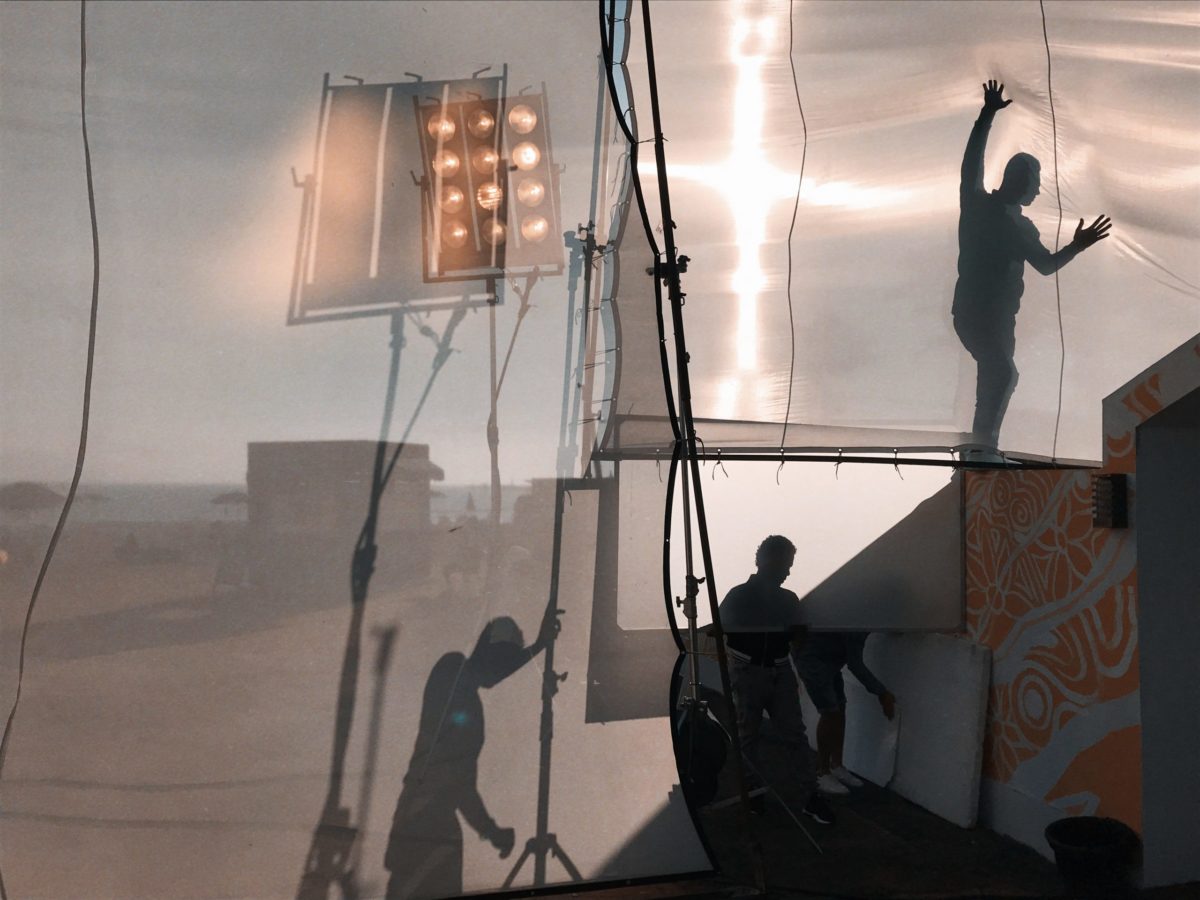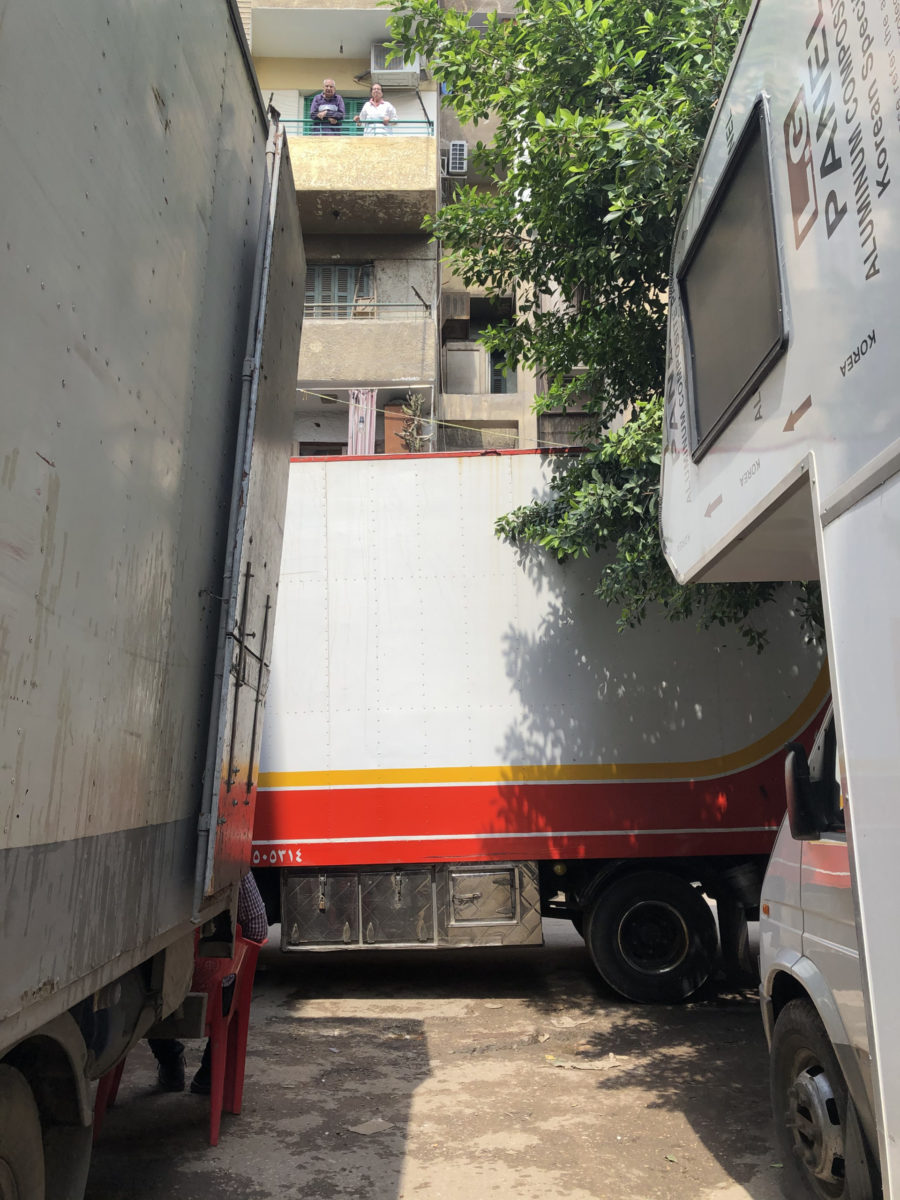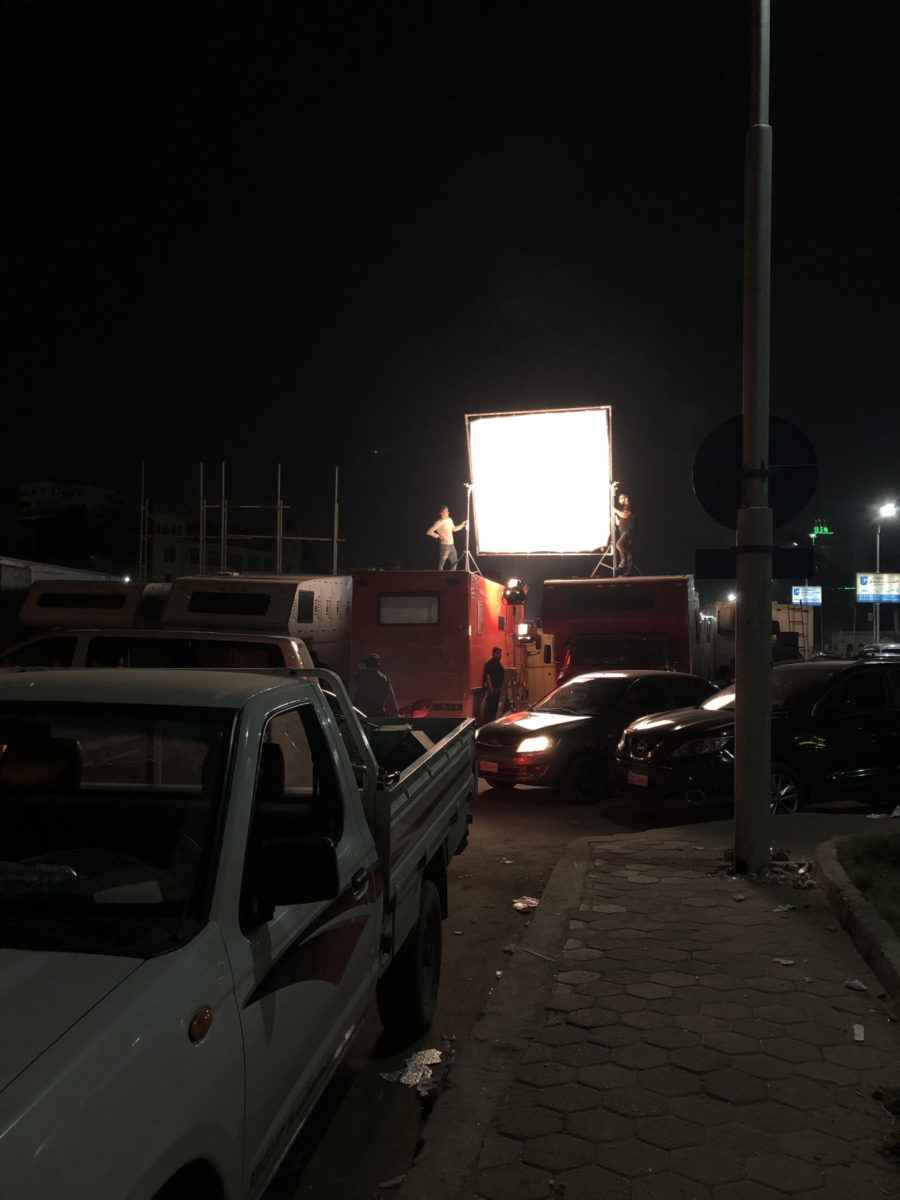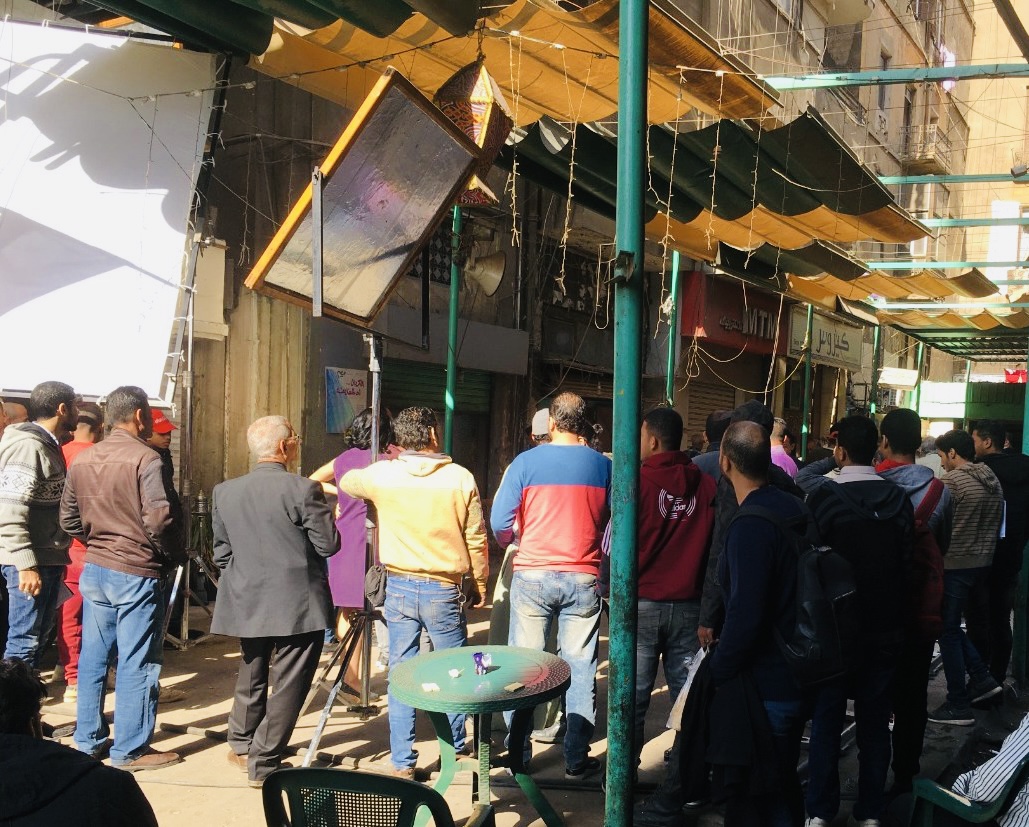
Technicians installing light defusing frames in preparation for filming, Egypt 2021. Maged Nader
Although it seemed impossible that the massive equipment and actors’ caravans would fit, the crew was able to place the trucks snug against the buildings, leaving just enough room for one or two people to pass. High voltage cables from the generator truck extended to the third floor of the building, mingling with the festive, colorful flags that zigzagged between balconies. Residents peeked from their windows and balconies to watch the commotion. Thankfully on this set—where the crew was filming a Ramadan television series—there were only a few minor arguments with those living in the neighborhood, which the production manager and the local fixer managed to quell.
Filming on location, or in the real world, attracts people from all walks of life, creating intense zones of contact and sometimes conflict. There are stories of film crews being kicked out of neighborhoods and of tensions escalating to physical violence. Crews that convert streets from their usual functions as places of dwelling, work and transportation into “artistic” sites for filming (whether for cinema, television or advertising) must be constantly ready for conflict and always calculating the risks.
The arrangements required to secure a filming location outside the predictable space of the studio illuminate the entanglements between the media and the city—not only symbolically and aesthetically but also economically, socio-politically and physically. In addition to the multiple necessary permits from the Egyptian government, and the systematic logistical preparations standard for any media production such as script breakdowns and scouting, filming in Cairo requires complex yet seemingly informal agreements with the people who have immediate authority over their streets. These people include kiosk owners, doormen and low-ranking traffic officers, who can render the state-issued permits useless if they wish. Media producers need to skillfully collaborate, negotiate and work with this structure of informal authority.
Filmmakers still rely heavily on the aesthetic authenticity of Cairo’s streets, despite the availability of private and government-owned studios and backlots, including the massive Media Production City (established in 1986). The unique historic architecture of certain areas—like Heliopolis or Shubra, the dense ambiance of popular areas like Ein Al Sira or Boulaq or the inimitable mise-en-scène of the downtown—cannot be easily replicated. This reliance on the city as a set, however, is also based on financial calculations by the producers—sometimes it proves economically advantageous to rent parts of the city rather than build them.

Residents peak from their balconies to watch the filming. Shoubra, Egypt, 2020. Mariz Kelada
Despite the substantial budgetary allocations for filming on location, production companies depend on a highly precarious and contingent labor force. Mohamed Serour, the late president of the Cinema Workers’ Trade Union, estimated that there were around 5,400 technical workers across the 18 professions he registered with the Egyptian Ministry of Labor in 2017, although the number may be much higher.[1] The usta (Arabic for craft master) hires and manages most of these workers, who include lighting technicians, wardrobe assistants, set builders, location services personnel and hairstylists. Although the head of each crew is likely to have an employment contract, those working for him generally do not have any job security, such as accident insurance or a period of guaranteed employment. While production budgets for films and television series range between approximately $1.6 million and $5.5 million, workers’ pay is a minor fraction of these budgets. For example, at the high end, between 2019 and 2020 (prior to the recent waves of inflation), a production assistant could earn approximately $80 per week on a television series, while a lighting technician could be paid as little as $14 per week.[2] Location expenses consume about 10–15 percent of the budget depending on the number of sites, criteria and the shooting duration. Peak employment in this sector corresponds with peak production for Ramadan television series, schools’ summer vacation and major holidays. These informal workers—predominately working-class men with a range of specialized skills—provide the foundational infrastructure for the film industry, but their status as seasonal workers without permanent contracts means that they fit the government category of “irregular labor.”
Policymakers and activists usually perceive informal labor as a problem. For policymakers, informal labor operates outside the state’s regulations and therefore cannot be taxed. For activists, informal laborers lack basic rights like health coverage, minimum wage and social security. Accordingly, informal laborers are either seen as evasive hustlers and stigmatized as criminals or as dispossessed victims of capitalism and failed welfare states. Although these characterizations may carry some truth, they also reduce the complexity of informal laborers’ lives. They obscure the dense processes, tactics and strategies of making a living in the contemporary neoliberal economy. Instead of the polarizing binary of formal versus informal labor, the case of Egyptian visual media—in particular filming in Cairo’s streets—shows that what is characterized as informal labor is not necessarily outside of the formal system. The seemingly informal exists in relation to the formal economy and sometimes even as integral to it. In particular, the system of film production in Egypt relies heavily on a complex network of individualized, informal arrangements and relationships between technical crews (who are themselves considered informal laborers), fixers and city residents.
On Location with Production Assistants and Neighborhood Fixers
To use the city as a film set is no easy feat. “No crew can shoot a minute in Nasr City, for example, without having an agreement with Shabaan,” Hady, a media production assistant in his mid-20s, told me.[3] Shabaan was a fruit seller in the area and had become a fixer over the years. Although not a formal part of the 10–15-person production crew, the fixer is the go-to person to secure a filming location in the city. Fixers maintain a semi-monopoly over shooting locations, whether apartments, shops or street corners. As Hady elaborated, “He [Shabaan] can take up to 10 percent commission from the production budget for locations. In the high season, he can have seven locations running. He wouldn’t be present; he’d still get a commission because his men will be facilitating things.” What Hady referred to as “his men” are the sub-fixers who are the middlemen between the primary fixer and even more localized areas. These sub-fixers enact the main fixer’s authority, but the fixer equally depends on the sub-fixers’ social connections within a particular neighborhood.
Mahmoud, in his mid-50s, has collaborated with Shabaan as a sub-fixer for about ten years. Mahmoud owns a kiosk on a side street in Nasr City and was approached by the production crew of a Vodafone commercial to use his kiosk as a filming location. Since then, this side job has become his primary source of income, and he has even roped his nephews into this line of work while they finished college. Mahmoud spoke about his experiences working as a sub-fixer for Shabaan in 2020:
Shabaan is the one who deals with me. Over time, he became one of the founders of shooting in the area. Word-of-mouth echoes and spreads if you secure good service. He is a very respectable guy—he is shaa’by [from a local, working-class background], but he knows how to deal with people and handle them. He calls and asks me to secure the parking of five big trucks for the lighting and equipment, which need to be close to the set or actors’ caravans. Since I know every sayies [a car parking concierge] in the area, I’d coordinate with sayies of that area, and I become the middleman between him and Shabaan—at the end, b-yradina.

Placing lighting reflectors on top of the actor’s caravans saved the time and money it would have cost for a professional, more secure, setup. It was only possible because of good relations between the different crews. Heliopolis, Egypt, 2020. Mariz Kelada
“B-yradina” (to appease or make us content) is a striking verb when talking about labor and money. In colloquial Egyptian Arabic, “yeradi” signals a mix of “compensating for something” and “buying agreeability,” and can signify a form of charity. The root of the verb is reda, which, depending on the context, can suggest satisfaction, contentment, goodwill and gratification. In this case, Mahmoud speaks about informal monetary transactions that are estimated by the payer and then assessed by the receiver as an acceptable amount or not. It is not a tip, although it bears a resemblance because the receiver is someone who facilitates minor tasks as services that are not obligatory. El meradia as a form of compensation for doing minor business, is laden with hierarchies of power. Since the verb also connotates “buying agreeability,” it signifies that the payer has more capital than the receiver yet still needs the receiver’s cooperation and help. Because it is a negotiated exchange and not a formal contractual agreement, there is always room for bargaining and even contestation by the receiver. In other words, in the case above, Shabaan (the person with money and monopoly) is also the person who needs the service that only Mahmoud (the person with immediate authority over his streets) can provide with his communitarian capital and his spatial embeddedness in the texture of the city.
The potential for contestation shows how securing permission to film on location includes more than just the exploitation of informal labor—of both the workers on the film crew and the fixers in the community—it requires a network of relationships with state agents acting on behalf of formal institutions. For example, Mahmoud clarified that he always held onto a copy of the shooting permissions so that no one would disrupt the shooting, including the police. Mahmoud lowered his voice and said: “Yes, they [the police] came this morning… but, you know, the local policemen know me well. Even if there is conflict and say we end up at the police station, I’d get us out of it. Everyone on the streets knows me. I know the owner of this nightclub you’re shooting in right now. I’ve been here since it was practically a desert with few buildings.” Mahmoud’s confidence in the strength of his relations with everyone in the area signals his dual capacity to both benefit media-makers by facilitating the filming and to ruin a filming day.
Like many sub-fixers of Cairo’s streets, Mahmoud’s example illustrates the importance of community relations, which are essential to successful filming. Although the fixer role might be viewed as informal and unskilled labor, it is the kind of “relationship management” work that corporations often highly compensate. Cairo’s residents who occupy key locations often manage to wring some money from the hands of fixers. And, in turn, expert fixers like Shabaan who have mastered the art of relationship management can develop a monopoly over certain areas and earn a decent income from the film industry.
Navigating the Relationship Between Film Crews and City Residents
Maher, a veteran producer in his mid-50s, told me once in an interview: “Kolo bel hob beyefok [everyone eases up with love]. This is how you handle work correctly under this capitalist mania.” I asked, “So ‘love’ is what makes things work, and capitalism benefits from it in the end?” Maher’s very matter-of-fact reply was, “Of course.” The expression bel hob (with love) is widely used to signify a non-contractual business agreement, where one works without the expectation of payment or a rigid work system. It can be understood as a continuation of el meradia, or even that both forms of labor management call each other into existence. For example, if an independent filmmaker needs a cinematographer, they may say, “I do not have a budget so it’s bel hob.” Accordingly, the cinematographer would assess if they like the project and the person enough to take the job for free, with the expectation of flexibility and good treatment in exchange for the favor. Yet, the cinematographer expects to benefit as well, in this case from the exposure.

Crowds gather around to watch filming, downtown Cairo, 2019. Mariz Kelada
On set, the lack of standard terms and rates of compensation for collaboration allows for the possibility of deceit. For example, Ahmed, a production manager in his mid-30s, embodies another articulation of bel hob because he is often praised for being fair and kind. A crewmate explained: “Ahmed makes everyone feel appreciated and more human because he does not try to trick people to save money for the producers like most production managers do.” This unique and recurring emphasis on el hob tells of the elusiveness of these relational practices that scaffold all the technical labor. Although the word translates to love and resembles a form of diplomacy or human resource management, it refuses the neat application of these terms—it carries a multitude of meanings.
Ahmed complicated the idea that bel hob is simply operationalizing niceness or being diplomatic. He emphasized that all the logistical preparations need to be supplemented with a substantive duration of hanging out in the location. He explained “You can’t just like a place and say, let’s film here. I must be in a place for at least a week so that people will get used to me and my face and my presence. You can’t just parachute into a place like that.” A film crew includes at least 120 people, who come with different mentalities and backgrounds. As Ahmed put it, they come “from the highest top to the lowest low of different classes and personalities.” The production crew members mediate and handle all transactions and altercations. I asked Ahmed if conflicts are always resolved with money. He replied with great intensity, “No, not at all. Even if very poor, some people refuse to take money to use their space. While other richer people can be super greedy, like: I want 20k if you want to film in front of my shop. We look like we are spending millions, and they want part of it, but it’s absurd! You must resolve things with them in whichever way. That the filming keeps going, that’s the most important thing.”
In that sense, different types of productions produce different kinds of problems. Bigger productions with famous superstars bring more unwanted attention to the set and require the production crew to fend off more intrusions and higher monetary demands. Karim, another production manager who works mainly in commercials, told me that if you are filming with a big star, “You virtually have to hide them, if you’re shooting for Vodafone [which for the past ten years has always featured a number of superstars], you’d say you’re shooting a Pampers or a pasta commercial.”
While trouble-shooting problems on set, film crews also rely on the notion of bel hob to find ways to rapidly build rapport with, and gain sympathy from, total strangers on the street to get a task done, such as making a driver wait to pass by until the shot is done. Another way of using bel hob is invoking and using personally shared connections, such as people one worked with in the past or even the city or area one is from, to find a middle ground in a disagreement or secure alliances on set. For example, I overheard a colleague on the production crew bragging about how he resolved a parking issue: “I asked him where he is from. He said I’m from Sayeda Zainab. I told him do you know this and that person, and he said yes. I told him, then we’re relatives—and everything worked out.” Another incident that exemplifies the expression in a filming location was when Mostafa, a lighting technician, burst out at the end of a workday from exhaustion and long hours almost yelling: “We’re not counted as humans in this occupation—we’re slaves!” I was walking towards him when I heard this and instantaneously, Abdo, my colleague on the production crew who was standing with Mostafa, called to me half-jokingly, “Come here doctor! Sign off on this,” to defuse the technician’s frustration by making him feel heard and validated. When we asked why he endures all this hardship, he paused a second, either hesitating or contemplating, then said: “because my boss is a good character, I can’t possibly let him down or act up and cause problems.”
These examples point to the multiple factors that are central to understanding how the city uses the film industry but also how the film industry uses the city. The ability to quickly recognize class distinctions and potential points of conflict becomes a profitable skill for production workers and, by proxy, for the film industry at large. They profit off the production workers’ ability to mediate the demands of city inhabitants without incurring the potentially higher cost of recourse to formal mediating institutions, like getting the police to set up professional barricades to block off roads or paying fines to municipal authorities for blocking access to a shopping center. Sometimes these formal state entities do have to be involved and paid, or paid off, especially if filming is occurring in a state-owned or run location like a mosque, touristic sites or a metro station.
On another level, production workers profit from the relationships they develop for the purpose of facilitating filming since it adds to the expert knowledge that elevates their status as good production crews and ensures their promotion. The people of the area may also profit from whatever small compensation they receive in exchange for acquiescing to being filmed, moving their laundry off the line or allowing a microphone to be mounted on their balcony—compensation they might never see if they relied on municipal authorities to distribute it after the fact. There are stark differences between the profits at the different levels of film production and the power attached to them, but each should be understood on their own terms. With that recognition, all the tactics by film crews and residents to benefit from filming on location reveal that the “urban poor” are not simply hustlers operating haphazardly or victims exploited helplessly.
Beyond the Binary of Formal and Informal Labor
Although filming in Cairo’s streets might appear informal and unruly, the processes of using the city as a set to make movies, television shows and commercials rely on the workings of multiple structures, such as class, state, industry, culture and social relations. More significantly, an analysis of media production shows how the people of the city and media-makers resource their knowledge of the city, society and the industry to get their jobs done by forging their own organizing systems. In this case, the experiences of laborers are more dynamic than in poverty discourses that associate informality with backwardness or exploitation. Examining media production practices reveals how an entire industry is dependent on informal precarious labor. This precarity stems not only from insufficient income, security and benefits but also from how the job requires constant recalibrations of risk and reward, personal and professional attitudes and tactics of relationship management.
Filming in Cairo’s streets offers a micro-study of precarious urban labor in Egypt as it moves across different city geographies, from the slums to the elite gated communities and everywhere in between. The production crews, primarily young male precarious workers, interface with diverse communities across the city to make a living. Each of these city areas is semi-autonomous and relies on the authorities of its inhabitants, despite the constant specter of the state’s presence. What can be called “informal labor” has a deeply ingrained legible system of operation that commands considerable authority. These ties are intricately multilayered, yet not completely haphazard, as they can appear at face value. Within these intricate ties, economic transactions happen unconventionally and proliferate, albeit unequally. These transactions defy the binary of formal versus informal as they retain their communal dependencies and simultaneously create alternative circuits of livelihood.
[Mariz Kelada is a Cairene cultural worker, a PhD candidate in anthropology and an MA student at the Department of Modern Culture and Media at Brown University.]
Endnotes
[1] The trade union is different from the cinematic occupational union, which houses workers such as directors, scriptwriters and cinematographers.
[2] The ethnographic work and interviews for this article were conducted while I was a production assistant in training between 2019–2021 and working on location during the filming of a Ramadan television series.
[3] All names of individuals and areas were changed for the purpose of research confidentiality.
